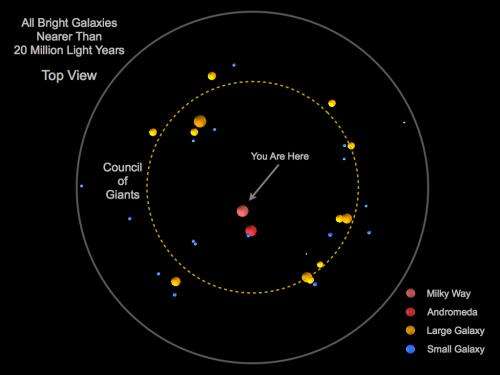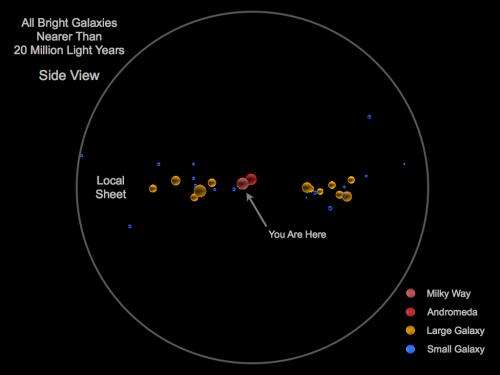Astronomers map out Earth's place in the universe among 'Council of Giants'

We live in a galaxy known as the Milky Way – a vast conglomeration of 300 billion stars, planets whizzing around them, and clouds of gas and dust floating in between.
Though it has long been known that the Milky Way and its orbiting companion Andromeda are the dominant members of a small group of galaxies, the Local Group, which is about 3 million light years across, much less was known about our immediate neighbourhood in the universe.
Now, a new paper by York University Physics & Astronomy Professor Marshall McCall, published today in the Monthly Notices of the Royal Astronomical Society, maps out bright galaxies within 35-million light years of the Earth, offering up an expanded picture of what lies beyond our doorstep.
"All bright galaxies within 20 million light years, including us, are organized in a 'Local Sheet' 34-million light years across and only 1.5-million light years thick," says McCall. "The Milky Way and Andromeda are encircled by twelve large galaxies arranged in a ring about 24-million light years across – this 'Council of Giants' stands in gravitational judgment of the Local Group by restricting its range of influence."

McCall says twelve of the fourteen giants in the Local Sheet, including the Milky Way and Andromeda, are "spiral galaxies" which have highly flattened disks in which stars are forming. The remaining two are more puffy "elliptical galaxies", whose stellar bulks were laid down long ago. Intriguingly, the two ellipticals sit on opposite sides of the Council. Winds expelled in the earliest phases of their development might have shepherded gas towards the Local Group, thereby helping to build the disks of the Milky Way and Andromeda.
McCall also examined how galaxies in the Council are spinning. He comments: "Thinking of a galaxy as a screw in a piece of wood, the direction of spin can be described as the direction the screw would move (in or out) if it were turned the same way as the galaxy rotates. Unexpectedly, the spin directions of Council giants are arranged around a small circle on the sky. This unusual alignment might have been set up by gravitational torques imposed by the Milky Way and Andromeda when the universe was smaller."
The boundary defined by the Council has led to insights about the conditions which led to the formation of the Milky Way. Most important, only a very small enhancement in the density of matter in the universe appears to have been required to produce the Local Group. To arrive at such an orderly arrangement as the Local Sheet and its Council, it seems that nearby galaxies must have developed within a pre-existing sheet-like foundation comprised primarily of dark matter.
"Recent surveys of the more distant universe have revealed that galaxies lie in sheets and filaments with large regions of empty space called voids in between," says McCall. "The geometry is like that of a sponge. What the new map reveals is that structure akin to that seen on large scales extends down to the smallest."
Journal information: Monthly Notices of the Royal Astronomical Society
Provided by York University





















